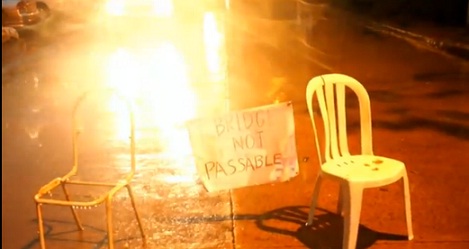VERA Files’ Luis Liwanag made the rounds of Quezon City. Here’s what he saw:
We pray that the number of casualties caused by the current flooding would not increase even as we cope with continuous rains.
I’d like to share notes from the “Disaster Preparedness and First Aid Handbook” produced by the Senate Committee on Climate Change chaired by Sen. Loren Legarda.
When warned of flood, here are the things you should do:
• Watch for rapidly rising flood waters.
• Listen to your radio for emergency and possible evacuation orders or instructions.
• Store drinking water in containers as water service may be interrupted.
• Move household belongings to upper levels.
• Transfer livestock to higher ground.
• If advised to evacuate, do so. Don’t panic. Move to a safe area before access is cut off by floodwaters.
• Turn off the main electricity switch and gas valve. Disconnect electrical appliances. Do not touch electrical equipment if you are wet or standing in water. Lock your house before evacuating.
During the flood,
• Stay indoors
• Do not attempt to cross rivers or flowing streams where water is above the knee.
• Do not go swimming or boating in swollen rivers.
• Do not drive through flooded areas or streets. Avoid needless trips.
• Stay away from downed power lines.
• Be alert for gas leaks. Use flashlight to inspect for damage.
• Report flooded areas to the Local Disaster Risk Reduction and Management Councils.
After the flood,
• Re-enter the house with caution using a flashlight, not lanterns or torches. Flammables and dangerous animals like snakes may be inside.
• Be alert for fire hazards like broken electric wires.
• Do not eat food and drink water until they have been checked for contamination.
• Report broken utility lines (electricity, water, gas and telephone) to appropriate agencies/authorities.
• Do not turn on the main switch or use appliances and other equipment until they have been checked by a competent electrician.
• Consult health authorities for immunization requirements.
• Do not go “sight-seeing” in disaster areas. You presence might hamper rescue and other emergency operations.
Pray, pray.

okey ang mga payong paalala sa handbook ni loren. bilib na sana ako sa kanya.
bakit?
ang tinitirhan niya ay siguradong hindi aabutin ng baha dahil nasa isang ligtas na lugar kaya hindi imposible sa kanya na makapag-isip ng mga gagawin kung sakali ngang malalagay siya sa katayuan ng ating mga pobreng kababayan.
marami siyang maaring tawagan na dagliang darating kung kakailanganin niya nga ang tulong.
madaling ipayo ng isang hindi kailanman dumanas ng nararanasan ng katulad naming halik na sa lupa sa paghihikahos.
loren, mas maige KUNG imulat mo ang iyong mata sa katotohanan.
ang dami mong magagandang sinasabi subalit hindi mo kayang pangatawanang ibahagi nang personal.
There are three important components to flood management and forecasting in which the conservation authorities are responsible:
Prevention. Informing planners and the general public about the risks of flooding to promote proper land use planning, preventing people from living and/or working in flood-prone areas. Conservation authorities are responsible for predicting flows and water levels within their watersheds, operating flood control structures, such as dams and disseminating flood warnings to local municipalities and agencies.
Protection. In order to protect against flooding, conservation authorities have constructed and maintain protective infrastructure, such as dams and dykes, or purchase lands located in hazardous areas. Stream gauges, weather stations, surveys of snow conditions, meteorological forecasts and computer models are used to forecast potential floods.
Emergency Preparedness and Response. Conservation authorities work with the Ministry of Natural Resources (MNR) to provide advice to municipalities for the preparation of flood contingency plans and to provide advice during the emergency response process. In Ontario, conservation authorities, and the MNR are responsible for forecasting where and when flooding is likely to occur and issuing flood alerts and warnings to local municipalities, the media, police and school boards. To facilitate this activity, conservation authorities and the MNR work closely with Environment Canada, Meteorological Services, who provide the weather information necessary to make the flood forecasting systems function effectively.
These advance warnings allow municipalities and other government agencies to put emergency response plans into operation, to evacuate communities and remove portable property from flood-susceptible areas. Advance warnings also notifies the public of developing or ongoing unsafe river and lake conditions, and allows them to take precautions.
There are four different flood messages:
FLOOD ADVISORY: notifies that the potential for flooding exists within specific watercourses and municipalities.
FLOOD WARNING: notifies that flooding is imminent or occurring within specific watercourses and municipalities.
FLOOD SAFETY BULLETIN: notifies that unsafe lake, river and channel conditions exist.
WATERSHED CONDITIONS BULLETINS: notifies of anticipated watershed conditions.
With Proper Planning and Less Politics, Flood Control and Environronemntla management is possible the Evolution of fllod control 60 uears After….http://www.hurricanehazel.ca/ssi/evolution_flood_control.shtml
Suggestion ko kay Loren: Ipakopya ng milyunes ang handbook na yan na wala syang pangalan na nagdudumilat sa cover at ipamudmod sa bahay-bahay ng mahihirap sa buong Pinas lalo dun sa mga madaling bahain na lugar. Nakakatulong kung nailalabas nga gaya dito sa blog ni ET pero limitado ang nakakabasa. Sincere lang ba na intensyon, gaya ng sinasabi ni Magno #1.